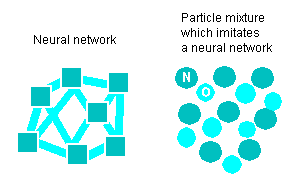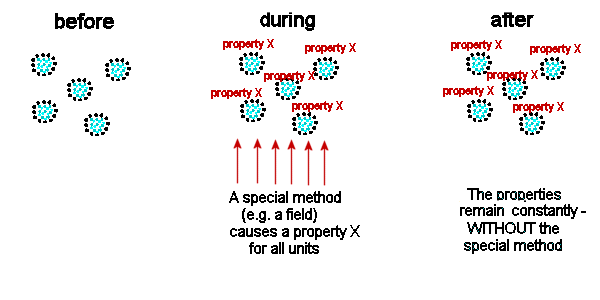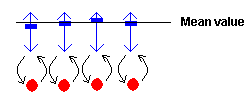|
Intelligent Nanosystems? Suggestions for further thought - A nanotechnology process for influencing system properties - A hypothetical NanoBot with a little neural network inside or another adaptive mechanism The following representation is primarily conceived as a stimulus for further thought. It is idealised and in part fictitious. Nevertheless, the process portrayed is trivial, allowing us to assume that it can be applied in the present or another form. |
|
Definition: A
nanoelement can be: - a composite of other nanoelements - a (specially designed) molecule or a sub-molecule - a nanoparticle in the usual sense - a composite of several different nanoparticles - an (intellectually bound) small region of a material - an elementary particle - any special construct on an atomic or subatomic level - any other micro-objects |
|
Preliminary observation: Influencing the
properties of a system in the desired manner
|
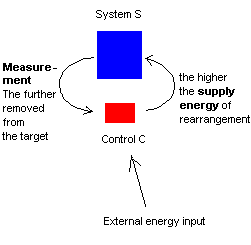 |
|
|
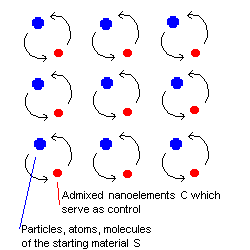 |
|
|
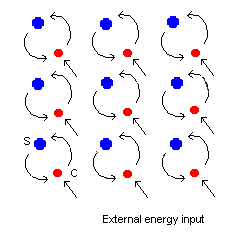 |
|
Fictitious application example 1: Resolving arrangement problems The starting material consists of a mixture of x and y particles. It is preferable that an x and a y particle each will be positioned beside each other or enter into a compound. The combinations x-x and y-y are therefore undesirable. To achieve this, special C and auxiliary elements are admixed with the starting material, which to a certain extent can “detect” whether the desired x-y combination is present in their environment, whereupon they inhibit the respective energy input. In other words, the application is shaken until a desired combination is present. Construction hierarchy: It could be created a construction hierarchy with various control nanoelements C1, C2, C3 ..., for example: - The C1 nanoelements make x-y connections. - The C2 nanoelements make s-t connections. - The C3 nanoelements make u-v connections. - The C4 nanoelements make w-z connections. A hierarchy level higher: - The C5 make xy - st connections (from C1, C2 results). - The C6 make uv - wz connections (from C3, C4 results). At the highest level: - The C7 make xyst - uvwz connections (from C5, C6). |
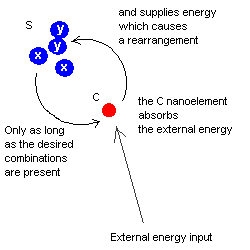 |
|
|
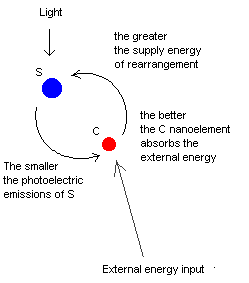 |
|
Optimising and realising the control by means of auxiliary nanoelements T nanoelement: In order to establish the control circuits, it could be helpful to admix special auxiliary nanoelements: e.g. transformation nanoelements, which transform the variations in one type of property into the variations in the other type of property. Several such T nanoelements can be connected in series. The property changes of T nanoelements do not necessarily have to be of a continuous nature. "Switch nanoelements" are conceivable, which activate a property if a condition is fulfilled and deactivate it again if the condition is not fulfilled. |
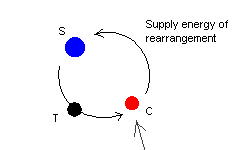 |
|
I nanoelement: Is unstable. If the energy input is increased it changes its property/properties randomly, which then interact with the starting material particle. It is helpful, as it were, when trying out different condition constellations Several distinct I nanoelements could create a certain degree of variety in the "trial space". I nanoelements can be switched with appropriate T nanoelements. In this way, additional types of random property are obtained. Note: Here S itself it not rearranged. instead only the external conditions are rearranged. |
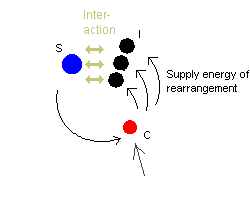 |
|
Admixing "intelligent" nano units L nanoelement: An intelligent nano unit is organised in such a way that it is always able to create the correct conditions at the correct time and at the correct place, depending on the instantaneous values of certain ambient conditions. An intelligent nano unit could imitate a neural network. Comparison:
|
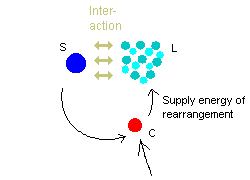
| |
|
T nanoelements as interface T nanoelements can serve the intelligent nano unit as an interface. The state of a neuron can influence the state of a T nanoelement and possibly vice versa. In other words, many types of T nanoelements would serve as an input and others as an output for the intelligent nano unit. |
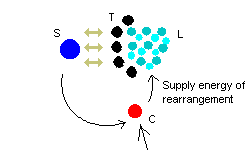 |
|
Special forms of intelligent nano units An intelligent nano unit could also be a molecule or a macromolecule (e.g. a fullerene, a nanotube, a DNA or other) or a combination of this. To realize the neural network "inside" the molecule, it must exist N, O and if necessary T nanoelemens in any form. See also: Quantum-Dot Arrays for Computation |
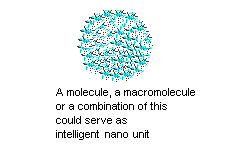 |
|
Other adaptive mechanisms But it must not necessary exist a neural network inside the intelligent nano unit. Could also be another adaptive mechanism, for example a set of I nanoelements or another recombinable arrangement of nanoelements, which are applicable for very simple information processing. |
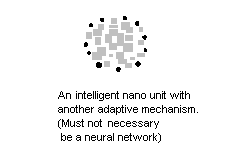 |
|
Creation of intelligent nano units with special functions - e.g. NanoBots In this example, the object of the evolution process is the intelligent nano unit itself. The goal is to create a desired physical, chemical, mechanical or information-processing behavior of the nanoelement unit. To make the nano unit complete, it must be admixed various T nanoelements. These are the inputs and outputs, the eyes and the extremities of the nano unit. Note: All graphics are shown in idealised form. In reality, the individual nanoelements could be variously mixed with each other. (All examples are fictitious) |
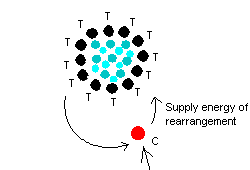 |
|
An intelligent nano unit has learned to serve as T nanoelement: It can detect a property of S and can send a signal to C. Another intelligent nano unit has learned to serve as control C: At a signal it sends energy to S. |
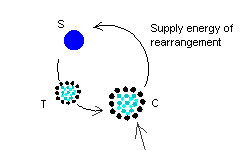 |
|
The intelligent nano unit C serves as teacher for a new nano unit. |
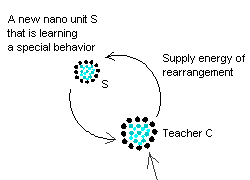 |
|
Could be a better way: It exists a little "rearragement nanoelement" inside the new nano unit S. Could be an energy absorber. It absorbes external energy at a signal from teacher C. |
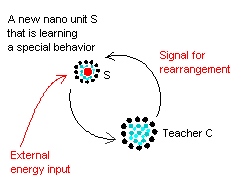 |
|
The intelligent nano units C1, C2 and C3 serve as teachers for a new nano unit. Each of these teachers could aim another teaching goal, so that the new nano unit could get a higher complexity. |
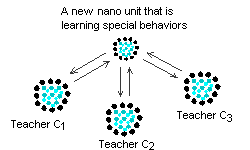 |
|
Perhaps in some cases would be applied the principle: Greater devices produce or teach smaller devices. |
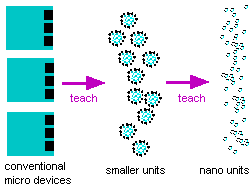 |
|
"Life-Phases" It could exist various phases in the life of a nano unit. Each phase would take place in another environment: 1.) Learning phase: The nano units are able to learn something only when a specific global external L-condition exists (e.g. a field or a specific energy form) 2.) Testing phase: The global external L-condition is off. The functions of the nano units are stable ("frozen"). Bad nano units are rejected during the test phase. 3.) Working phase: The global external L-condition remains in off-status. The nano units can go to work. 4.) Self-destroying phase: At a signal a special nanoelement would be activated that initiate the self-destroying (e.g. by absorption of to much energy) |
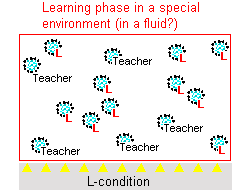 |
|
Self-learning NanoBots The teacher (red) is integrated into the freemoving nano unit. The graphic is idealised. The teacher has two "sensors" to test the environment here. Always, if the nano unit shows an undesired behavior, the teacher (red) sends energy of rearrangement to the adaptive nanoelements. (The NanoBot learns always, i.e. no L-condition necessary.) (The NanoBot without adaptive nanoelements is not self-learning but it could be useful in special cases. The energy of rearrangement causes random changes of the T nanoelements. The NanoBot would be a stochastic, freemoving searcher.) |
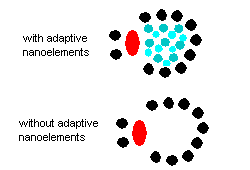 |
|
One local teacher for each nano unit versus one global teacher for many nano units Both methods have advantages and disadvantages. A global, external teacher wouldn't "know" the local conditions of each nano unit. However, a local teacher could optimally tune the relations between the nano unit and the environment. On the other hand, a global, external teacher would allow a massively parallel process. The only teacher could be e.g. an external computer. Perhaps in some cases both methods can be combined. Based on discussion |
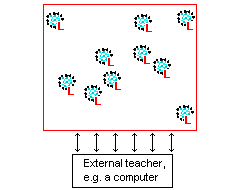 |
|
Nano units with Associative Memory Nano units with an Associative Memory based neural network inside could hypothetically give us the possibility to use only one global, external teacher for many nano units. All the nano units would learn synchronously and massively parallel. |
For example, the nano units have to learn: If input 1 then output x If input 2 then output y If input 3 then output z Neural networks with Associative Memory can learn this in the following way: The external teacher sends the associated signals to all the nano units always at the same time. The signal 1 and the signal x are externally(!) and globally(!) created at the same time. And so signal 2 and signal y. And so signal 3 and signal z. And so on. |
|
The property A could be: |
|
|
Creation of functional solid structures For example: A type 2 nano unit can only connect with type 1 nano unit and type 3 nano unit. In this way it could be created larger structures by self-construction e.g. in a fluid. Some special types of nano units could serve as docking points for special molecules or other nanoelements. See also: Amorphous computing http://www.swiss.ai.mit.edu/projects/amorphous/ |
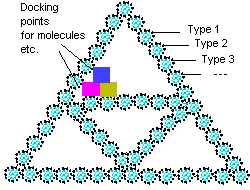 |
|
Mechanical machines The intelligent nano unit has learned to rotate when a local(!) event happens. (Note 1: If necessary, it could also learn to rotate always. But for the construction of machines an event-oriented behavior is important.) (Note 2: It could be applied a global external and constant field. And some field-sensible T nanoelements could be mixed with the nano unit to realize a motor effect.) |
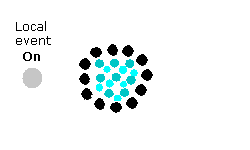 |
|
Can adaptive nano units "learn" to decrease noise and disturbances? The effect could be similar to magnetic field cooling... Would be possible a local und short temporal cooling? (By the way: Perhaps it could be created any other useful physical effects, e.g. heat pump) |
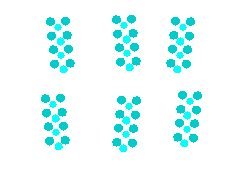 |
|
Nanofactory Perhaps such nanoelement units can learn to react specifically: At event1 do this, at event2 do that - so that small machines could be constructed by combination of several nanoelement units (must not necessarily be mechanical machines). Possibly this could be helpful to realize molecular manufacturing - the primary goal of nanotechnology. Link: http://en.wikipedia.org/wiki/Nanofactory |
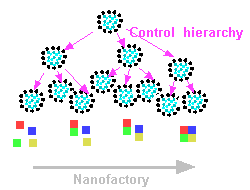 |
|
Adaptive nano units versus conventional nano units We want to construct a machine with following functions. Always, if event1 then do x Always, if event2 then do y Always, if event3 then do z In the macroscopical and in the micro world, we wouldn't use adaptive mechanisms or neural networks for these simple tasks. But in the nanoworld, it's very difficult to arrange the components of the machine, because of the smallness and noise and disturbances. In some cases it would be easier if the logic of the machine "constructed" itself - by a kind of learning process. And this a reason for the suggestion to use a little neural network or other adaptive mechanism in each nano unit. And not only the machine logic would "construct" itself. Also the relations between the nano unit and the environment would "construct" itself (see above "Self-learning NanoBots"). However, in the future conventional nano units could be more important than adaptive nano units. Perhaps both forms could be combined. And possibly, adaptive nano units will help to create the first complex conventional nanofactory. And everytime adaptive nano units could be used for special applications: optimization processes (e.g. see energy converter above) and in fundamental research work (see below). |
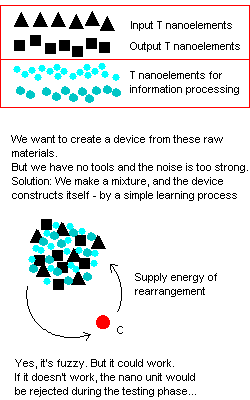 |
|
Unexpected new potential applications? Chains of effect could exist in the diversity of the microcosm, which are still unknown to science and which could be utilised indirectly – without knowing it - as the set of conditions organises itself, as it were. A fictitious example: The issue should be examined whether the gravitational force depends on any inner structural conditions of the masses involved. In other words: we wish to attempt to reduce the weight of a mass, at least (very) slightly. It only depends on the evidence! (It is certainly science fiction. But we need some form of example!) Piezoelectric nanoelements are admixed with the starting material S. The control nanoelement C must be able to realise the following: The higher the weight of an S particle, i.e. the higher the voltage generated by the piezoelectric effect, the higher the absorbed energy (and hence the energy supplied to the S particles). It is certainly difficult or even impossible to create corresponding test conditions for this experiment. Other forces must be kept as small as possible, for example. However, this is not the crucial point. The above example should be taken as representative for the fact that we should not be afraid of examining even unusual questions. |
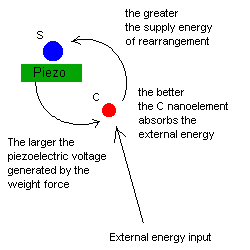 |
|
Applications in fundamental research work Each property, each equilibrium and each apparently unalterable regularity could be of a purely statistical nature below the surface or could act dynamically. The process described may provide an opportunity to shift properties and equilibria into areas not previously there. It could therefore be worthwhile to experimentally influence those states of a system which were previously believed to have been constant and not capable of being influenced. |
Example: A microphysical property K is given.  Outwardly the value of property K appears constant and not capable of being influenced. In reality, however, it represents a mean value for various (fluctuating) individual values. However, we do no yet know that at this time point .
Admixing special nanoelements C with the material, which energetically favour property values, leads to the discovery that the property originally believed to have been unvarying can now nevertheless be influenced, which could of course be of significant scientific or even practical interest. |
|
External control unit C The following configuration is perhaps adequate for certain applications: Only the L and T nanoelements are admixed with the material. The only control unit C (electrical circuit, computer) is located outside the material this time. Certain systems capable of self-organisation from the outset (e.g. living tissue) could now be left unchanged, while an attempt could be made to influence these in the desired manner just with an external control. In this way, it may be possible to support the healing process for diseased tissue. In the case of a "disease signal", the energy is increased, otherwise it would be reduced. (Possibly already applied.) |
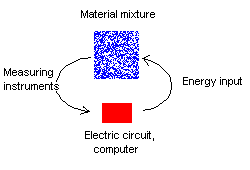 |
|
Generalisation In the above versions, the control circuits were realised by the admixture of nanoelements and by active energy input. Strictly speaking though, these are only special cases. In many cases, it could be worthwhile considering otherwise. The following questions should be examined: What is the aim? What properties are required for the system? What depends on this property causally? Is there an indicator for this property? What can I activate or deactivate with it? Can I establish a causal chain so that I can eventually activate or deactivate the rearrangement of the system? How can I bring about a rearrangement in the relevant parts of the system? Increased energy input is only one option. However, if we consider the distinct features of the system, there are certainly other options as well for loosening or even separating certain structures and bonds. Certain functions of these control circuits could possibly be attained through skilful modifications to definite system properties, i.e. it is now achieved through changes in the system itself – without admixing any nanoelements. |
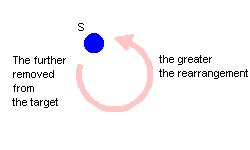 |
|
Fictitious generalisation example A: The work of T and C nanoelements assumes certain system functions here. T and C are therefore not material particles. The control circuit is now completely within the starting system S. The control circuit could be set up through skilful modification of the system properties. |
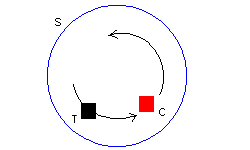 |
|
Fictitious generalisation example B: The T nanoelement serves as a switch here: If the desired property is not present, T assumes a property which causes a rearrangement in S. |
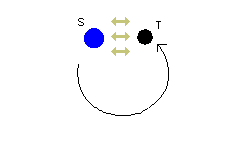 |
| Remarks |
|
Mixing The above graphics are shown in idealised form. In reality, the individual particles (nanoelements) would be variously mixed with each other. Nevertheless, there are special forms of mixing: - Arrangement of the materials in layers (interfaces) - For gases: Leading the gas away via a material - Regular arrangement of the micro-units (as with chip production) Modular system Actually, for all applications only a single nanoelement type is required as control unit C as well as a single type of "intelligent" nano unit. Everything else could be realised through a combination of corresponding transformation nanoelements T. Connecting these T nanoelement in series could enable any chains of effect to be realised. It could therefore be possible to provide a type of modular system comprising connectable nanoelements. Universally applicable measuring device for diagnostic and research purposes The device would essentially consist of a membrane whose surface is covered with specific control nanoelements C and auxiliary nanoelements. The device would also ensure the corresponding external energy input to the membrane in the above sense. A sample of starting material could now be positioned on this membrane, and with the aid of conventional measuring instruments which do not necessarily have to belong to the device, it would be possible to look for possible effects (change in the properties of the starting material). Automated "variant research" A mixture of many different materials M1..Mn can be brought together so that very varied physical interactions can occur. Depending on the purpose of the research, C and other auxiliary nanoelements are then added. The ingredients M1...Mn are now varied. Materials are (partially) removed or added again in an automated process. It is also monitored each time whether the effect has increased. In this way, we can perhaps find out what materials are relevant for the effects. The simultaneous use of different control units C Occasionally it may be necessary to use several different control units within a material – for example if several objectives are to achieved at the same time or a definite side effect is to be avoided. This is because the process could be used equally well for "suppressing" properties. Temperature As the set of conditions must be correspondingly "loosened up", the process might only function at certain higher temperatures. Moreover, a process application should be taken into consideration during a cooling process. The new system properties might then remain, without the process application always being permanently maintained. Hierarchy For several applications, it may be appropriate to establish a type of hierarchy for the control circuits. Small circuits are controlled by larger ones, and the latter in turn by even larger ones ... (imitation of self-organisational processes in living beings) (2001, Author: Carsten Zander, Carsten.Zander@t-online.de)
|
